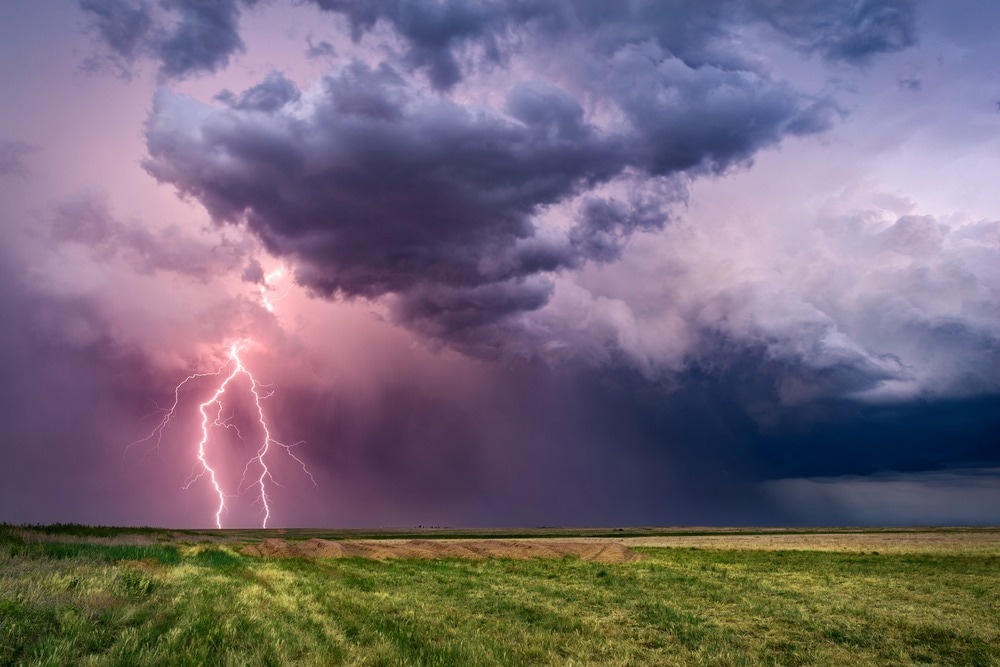A study published in Urban Science worked on the monthly climatology of lightning flash rate concerning the atmospheric aerosol optical depth and various thermodynamic parameters to investigate the trend and pattern of thunderstorm lightning.

Study: Relationship between Lightning and Aerosol Optical Depth over the Uttarakhand Region in India: Thermodynamic Perspective. Image Credit: John D Sirlin/Shutterstock.com
Researchers studied the effect of atmospheric aerosol concentration on lightning over the western Himalayas. The study provides a direction toward the future use of monthly, hourly, or daily data for predicting lightning flash rates, which will help mitigate lightning damage.
Role of Aerosol and Thermodynamic Parameters in Lightning Activities
Lightning is a natural phenomenon generated by thunderstorms' huge voltage differences. It damages commercial structures, residential and industrial electronic and electrical equipment, and human life. Lightning is influenced by various surface and atmospheric phenomena.
The atmospheric convection, determined by thermodynamics, and aerosols, governs lightning and its intensity. Numerous research has helped determine the influence of aerosols on clouds and lightning. Aerosols integrate and regulate deep convective clouds, which results in more intense lightning strikes in humid environments.
Aerosol loading influences the thermodynamic parameters of the atmosphere and, therefore, convective available potential energy (CAPE). CAPE governs updraft strength and lightning intensity and determines the instability of the atmosphere during humid convection.
Moisture content, local aerosol loading, and CAPE are also influenced by vegetation cover and health, often represented using the normalized difference vegetation index (NDVI).
Deep-rooted forest regions store a substantial quantity of water, which affects convective growth, latent heat flow, and lightning activity. Therefore, NDVI plays a crucial role in transmitting heat from plants in the form of latent heat flux, which can trigger the generation of lightning activity in various mountain regions.
Research Area: The Himalayas
The Himalayan region is one of the lightning flash rate hotspots in the world; however, as it is challenging to identify a single mechanism that adequately explains the lightning activity, there is limited research on the role of aerosols in lightning activities over this area.
Therefore, it may be necessary to apply unique empirical relations or parameters to estimate the precise cause of lightning over the Himalayas.
Assessment of Lightning and Aerosol Optical Depth Using High-Resolution Monthly Climatology Datasets
An optical transient detector and a lightning imaging sensor aboard the tropical rainfall measuring mission (TRMM) provided the required lightning data. Aerosol optical depth (AOD) measurements at 550 nm were analyzed using a moderate-resolution spectroradiometer.
The dependency of lightning flash rate was examined using thermodynamic parameters. The categorization of aerosols based on the values of the AOD and the Ångström exponent identified the potential sources of aerosols that influence lightning intensity.
The thermodynamic relationship between the sum of the evaporation and precipitation rate and the product of the Bowen ratio was utilized as a proxy to quantify the lightning flash rate density over the study area using complex models from the coupled model inter-comparison project-phase 5 (CMIP5).
Lastly, projections for possible lightning were generated using the model-simulated lightning flash rate.
Significant Findings of the Study
Complex local thermodynamic variables, including topography, climatic parameters, and atmospheric aerosols, influence the frequency of lightning across any location. In addition, aerosol loading has secondary effects on the atmosphere, one of which is a shift in the radiation budget.
There is a strong correlation between lightning flash rate density and atmospheric aerosol concentration. The vertical movement of air governs the water vapor concentration and shift in the moisture gradient, leading to strong electrification in convective clouds.
However, during the winter and post-monsoon seasons, the absence of vertical updraft owing to low temperatures and a thin boundary layer height may prevent increased AOD levels from impacting lightning.
The topography and climatology of the northwest and northeast regions of the research area were significantly different. The moist northeast area had lower terrain elevation, more vegetation cover, and increased lightning activity.
In the dry northwest, terrains with steeper slopes or higher elevations are more prone to lightning activity, even with low humidity and vegetation cover. However, at the onset of the monsoon in mid-June, convective activity and humidity tend to rise over this region, but lightning appears to decrease during the monsoon season.
In the future, high-resolution hourly data will be required for precise assessment of aerosol optical depth and lightning as monthly data makes it challenging to investigate seasonal impacts.
Reference
Gautam, A.S., Joshi, A., Chandra, S., Dumka, U.C., Siingh, D., & Singh R.P. (2022) Relationship between Lightning and Aerosol Optical Depth over the Uttarakhand Region in India: Thermodynamic Perspective. Urban Science. https://www.mdpi.com/2413-8851/6/4/70
Disclaimer: The views expressed here are those of the author expressed in their private capacity and do not necessarily represent the views of AZoM.com Limited T/A AZoNetwork the owner and operator of this website. This disclaimer forms part of the Terms and conditions of use of this website.